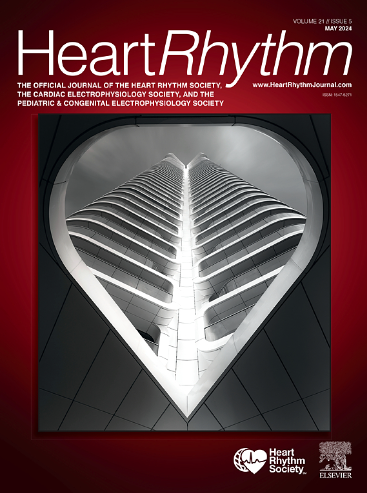心脏病患者室性心动过速与1:1 His-V关系的机制
IF 5.7
2区 医学
Q1 CARDIAC & CARDIOVASCULAR SYSTEMS
引用次数: 0
摘要
背景:室性心动过速(VT)与1:1 V-His的关系可以在束状分支再入(BBR)或疤痕相关VT (SRR-VT)被动逆行激活或左心室(LV)浦肯野束(FPVT)再入中看到。目的:回顾1比1 V-His关系发生的频率,并识别这些心律失常的鉴别特征,包括在右心室起搏(RV)时基于His-近端右束电位(HisRB)捕获和HisRB刺激(S-HisRB)间期近似RV电图与His间期(Egm-HisRBVT)的新测量。方法:回顾性回顾从右心室远端起搏时记录HisRB电位的诱导心室。结果:147例患者共158例VTs进行分析。在86例(54%)VTs中观察到1:1 V与HisRB: 18例BBR-VTs, 8例LV束状/ purkinji相关的再入性VTs (FPVT), 60例疤痕相关的再入性VTs (SRR-VT)。HisRB-QRS为135msec, 87%的SRR-VT在QRS范围内;结论:逆行性HisRB激活在所有类型的VT中都很常见。HisRB的时间和基于RV起搏时HisRB正态激活的新特征可以帮助区分BBR、SRR-VT和fpvt。本文章由计算机程序翻译,如有差异,请以英文原文为准。
Mechanisms of ventricular tachycardias with a 1:1 His-V relation in patients with heart disease
Background
Ventricular tachycardia (VT) with a 1:1 V-His relation can be seen in bundle branch reentry or with passive retrograde activation from scar-related VT or reentry using left ventricular Purkinje fascicles.
Objective
This study aimed to review the frequency with which 1:1 V-His relation occurs and to identify differentiating characteristics of these arrhythmias, including new measures obtained during right ventricular (RV) pacing based on orthodromic His–proximal right bundle potential (HisRB) capture and the stimulus to HisRB (S-HisRB) interval approximating RV electrogram to His interval (Egm-HisRBVT).
Methods
This was a retrospective review of induced VTs that had a HisRB potential recorded while pacing from the distal right ventricle.
Results
From 147 patients, 158 VTs were analyzed. A 1:1 V to HisRB was observed in 86 VTs (54%): 18 bundle branch reentrant VTs (BBR-VTs), 8 LV fascicular/Purkinje-related reentrant VTs (FPVTs), and 60 scar-related reentrant VTs (SRR-VTs). The HisRB-QRSVT was >135 ms, falling within the QRS in 87% of SRR-VTs, and 30–135 ms in all BBR-VTs (P < .001). With RV pacing, the HisRB remained 1:1 in 100% of BBR-VTs and 23 (69.7%) of 33 SRR-VTs. An S-HisRB of >135 ms combined with S-HisRB – Egm-HisRBVT difference <30 ms was specific for BBR-VT. In FPVTs, the HisRB-QRS timing was more variable, and RV pacing was helpful in distinguishing these from BBR-VTs.
Conclusion
Retrograde HisRB activation is common in all forms of VT. HisRB timing and new features based on consideration of orthodromic HisRB activation during RV pacing can help distinguish BBR-VT, SRR-VT, and FPVT.
求助全文
通过发布文献求助,成功后即可免费获取论文全文。
去求助
来源期刊

Heart rhythm
医学-心血管系统
CiteScore
10.50
自引率
5.50%
发文量
1465
审稿时长
24 days
期刊介绍:
HeartRhythm, the official Journal of the Heart Rhythm Society and the Cardiac Electrophysiology Society, is a unique journal for fundamental discovery and clinical applicability.
HeartRhythm integrates the entire cardiac electrophysiology (EP) community from basic and clinical academic researchers, private practitioners, engineers, allied professionals, industry, and trainees, all of whom are vital and interdependent members of our EP community.
The Heart Rhythm Society is the international leader in science, education, and advocacy for cardiac arrhythmia professionals and patients, and the primary information resource on heart rhythm disorders. Its mission is to improve the care of patients by promoting research, education, and optimal health care policies and standards.
 求助内容:
求助内容: 应助结果提醒方式:
应助结果提醒方式:


